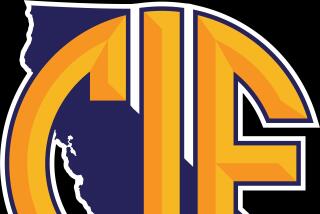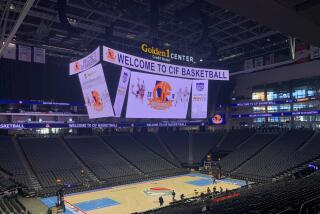NCAA’s Changes Are Not Deep--Not Yet Anyway
NASHVILLE, Tenn. — To measure the significance of what occurred at the 85th annual NCAA convention, which concluded here Thursday, consider breadth and depth.
Although the membership passed legislative proposals unprecedented for the number of areas affected, substantive reform was moderate.
There were some significant moves in membership structure, but in the areas that matter most to the public’s perception of intercollegiate athletics, it was only a start.
“On a scale of 1 to 100, it’s about a 6,” said Gary Roberts, a sports-law professor who chairs Tulane’s faculty senate committee on athletics and was among the school’s convention delegates. “It’s better than the 1s and 2s we’d been having, but fundamental reform really hasn’t been addressed.
“The basic incentive to engage in unethical conduct is still there. This will not make the problems go away, although it’s a step in the right direction.”
It’s a step that is bound to be refined in the near future, as the NCAA begins to make an extremely important change -- the one for which this convention may be most remembered.
Apparently the organization will no longer try to paint one detailed portrait of reform that won’t sell to its members. Instead, it will rough in visions with a couple of rollers, then go back and make the image come to life by using many brushes.
“I think for the next three or four years, you will see change and fine-tuning, change and fine-tuning,” Big Ten Conference Commissioner Jim Delany said. “In the three or four days we have here, we can’t change the world. But in the next five, six, seven years, we can produce a different kind of conduct, and start building an atmosphere and a system that people are more comfortable with.”
The presidents finally seem able to lead the way. For example, when a 1988 survey of student-athletes showed they were spending about 30 hours a week on their sports, the presidents thought it important to try to reduce the amount of time student-athletes were spending on practices and games.
With student-athletes and coaches from different sports pleading their cases, the Division I and Division II schools voted that starting with the 1991-92 school year, there will be limits on in-season practice and competition of 20 hours per week and four hours per day, with one day off per week required. There also will be out-of-season, organized-practice-time limits of eight hours per week for weight and conditioning activities, football spring practice being excepted.
Arizona State associate athletic director Herman Frazier said the necessary record-keeping would be “a nightmare.” And one athletic director predicted the rule would be enforced “like the 55-mile-an-hour speed limit.”
However, it was passed with the ideas that the concept is good, that these limits are a place to start, and that the issue can be addressed again.
“The immediate next step needs to be to come back and fine-tune that on a sport-by-sport basis,” NCAA Executive Director Dick Schultz said. “I’ve always had the position that ... there’s too much difference in sports to have standard legislation.”
The legislation that sets up a 10 percent cut in the number of scholarships Division I schools can offer might be revisited next year. So might several other pieces of legislation.
The NCAA Presidents Commission, which provided a great deal of the political clout that got these proposals passed, will stay involved, but likely move on to new concepts. “I think this convention signaled to them how important they are to the process,” newly elected NCAA president Judith Sweet said.
“The price of failure in the management of the athletic program on a campus has become very high,” said Wake Forest President Thomas Hearn, a member of the Presidents Commission. “The level of interest on the part of governing boards in these matters is very high. ... (That) means that the involvement of the presidents is likely to stay firm and solid, I think.”
The major issue for the presidents in the upcoming year-academics-could be far more contentious than any of those considered here. Proposals concerning changes in the NCAA’s enforcement procedures also could come up. A likely attempt for new requirements for freshman eligibility and eligibility in each successive year promises to receive the most attention.
Hearn, who also is a member of the Knight Commission on intercollegiate athletics, which is scheduled to issue its report in March, said, “It’s going to be difficult to craft a kind of legislation which will accomplish what the NCAA wants -- which is laudable -- but which will not at the same time violate a kind of sacred prerogative of faculty right.”
And tinkering with such legislation from year to year is not always practical. Part of the rationale given for not passing legislation that would alter the so-called Proposition 48 requirements for freshman eligibility (700 SAT score or 18 ACT in addition to a 2.0 grade-point average in core courses) was that they had to be given time to work, and time was needed to study their effectiveness and utility as a predictor of academic success.
“I think it will be a real challenge,” Delany said of getting new proposals approved. “I think it’s possible, but we’ll have to be creative.”
Roberts said they also will have to be fast. “It’s a question of how many years we can keep this momentum going,” he said. “Sooner or later, the coaches and ADs are going to start screaming so loudly that it’s going to come to an end. The question is will there be some real important, basic reforms before that happens.”
More to Read
Go beyond the scoreboard
Get the latest on L.A.'s teams in the daily Sports Report newsletter.
You may occasionally receive promotional content from the Los Angeles Times.










